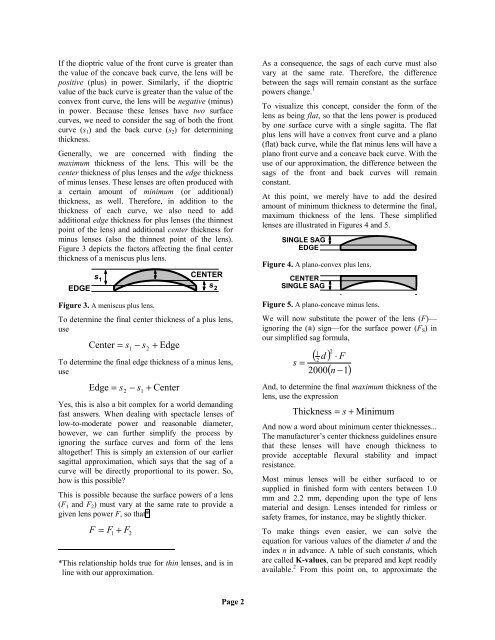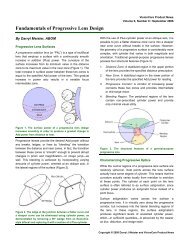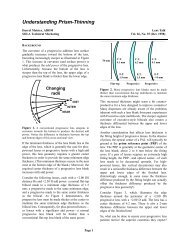Methods for Estimating Lens Thickness - Laramy-K Optical
Methods for Estimating Lens Thickness - Laramy-K Optical
Methods for Estimating Lens Thickness - Laramy-K Optical
Create successful ePaper yourself
Turn your PDF publications into a flip-book with our unique Google optimized e-Paper software.
If the dioptric value of the front curve is greater than<br />
the value of the concave back curve, the lens will be<br />
positive (plus) in power. Similarly, if the dioptric<br />
value of the back curve is greater than the value of the<br />
convex front curve, the lens will be negative (minus)<br />
in power. Because these lenses have two surface<br />
curves, we need to consider the sag of both the front<br />
curve (s 1 ) and the back curve (s 2 ) <strong>for</strong> determining<br />
thickness.<br />
Generally, we are concerned with finding the<br />
maximum thickness of the lens. This will be the<br />
center thickness of plus lenses and the edge thickness<br />
of minus lenses. These lenses are often produced with<br />
a certain amount of minimum (or additional)<br />
thickness, as well. There<strong>for</strong>e, in addition to the<br />
thickness of each curve, we also need to add<br />
additional edge thickness <strong>for</strong> plus lenses (the thinnest<br />
point of the lens) and additional center thickness <strong>for</strong><br />
minus lenses (also the thinnest point of the lens).<br />
Figure 3 depicts the factors affecting the final center<br />
thickness of a meniscus plus lens.<br />
EDGE<br />
s CENTER<br />
1<br />
s 2<br />
Figure 3. A meniscus plus lens.<br />
To determine the final center thickness of a plus lens,<br />
use<br />
Center = s − s2<br />
1 +<br />
Edge<br />
To determine the final edge thickness of a minus lens,<br />
use<br />
Edge = s − s1<br />
2 +<br />
Center<br />
Yes, this is also a bit complex <strong>for</strong> a world demanding<br />
fast answers. When dealing with spectacle lenses of<br />
low-to-moderate power and reasonable diameter,<br />
however, we can further simplify the process by<br />
ignoring the surface curves and <strong>for</strong>m of the lens<br />
altogether! This is simply an extension of our earlier<br />
sagittal approximation, which says that the sag of a<br />
curve will be directly proportional to its power. So,<br />
how is this possible?<br />
This is possible because the surface powers of a lens<br />
(F 1 and F 2 ) must vary at the same rate to provide a<br />
given lens power F, so that*<br />
F = F 1 + F 2<br />
*This relationship holds true <strong>for</strong> thin lenses, and is in<br />
line with our approximation.<br />
As a consequence, the sags of each curve must also<br />
vary at the same rate. There<strong>for</strong>e, the difference<br />
between the sags will remain constant as the surface<br />
powers change. 1<br />
To visualize this concept, consider the <strong>for</strong>m of the<br />
lens as being flat, so that the lens power is produced<br />
by one surface curve with a single sagitta. The flat<br />
plus lens will have a convex front curve and a plano<br />
(flat) back curve, while the flat minus lens will have a<br />
plano front curve and a concave back curve. With the<br />
use of our approximation, the difference between the<br />
sags of the front and back curves will remain<br />
constant.<br />
At this point, we merely have to add the desired<br />
amount of minimum thickness to determine the final,<br />
maximum thickness of the lens. These simplified<br />
lenses are illustrated in Figures 4 and 5.<br />
SINGLE SAG<br />
EDGE<br />
Figure 4. A plano-convex plus lens.<br />
CENTER<br />
SINGLE SAG<br />
Figure 5. A plano-concave minus lens.<br />
We will now substitute the power of the lens (F)—<br />
ignoring the (±) sign—<strong>for</strong> the surface power (F S ) in<br />
our simplified sag <strong>for</strong>mula,<br />
s =<br />
2000<br />
1 2<br />
( d ) ⋅ F<br />
2<br />
( n −1)<br />
And, to determine the final maximum thickness of the<br />
lens, use the expression<br />
<strong>Thickness</strong> = s + Minimum<br />
And now a word about minimum center thicknesses...<br />
The manufacturer’s center thickness guidelines ensure<br />
that these lenses will have enough thickness to<br />
provide acceptable flexural stability and impact<br />
resistance.<br />
Most minus lenses will be either surfaced to or<br />
supplied in finished <strong>for</strong>m with centers between 1.0<br />
mm and 2.2 mm, depending upon the type of lens<br />
material and design. <strong>Lens</strong>es intended <strong>for</strong> rimless or<br />
safety frames, <strong>for</strong> instance, may be slightly thicker.<br />
To make things even easier, we can solve the<br />
equation <strong>for</strong> various values of the diameter d and the<br />
index n in advance. A table of such constants, which<br />
are called K-values, can be prepared and kept readily<br />
available. 2 From this point on, to approximate the<br />
Page 2









